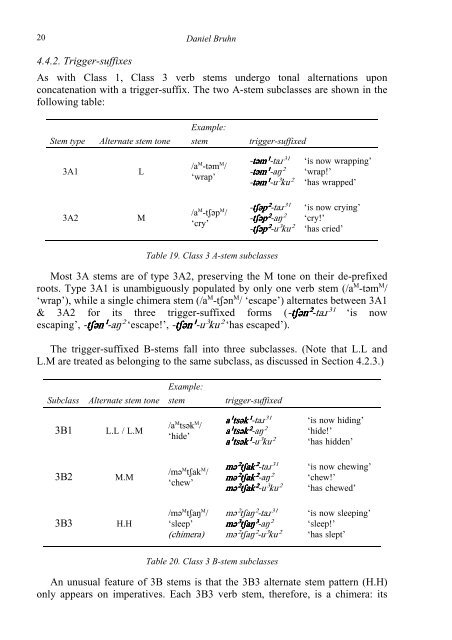A TONAL TAXONOMY OF CHUNGLI AO VERBS Daniel Bruhn ...
A TONAL TAXONOMY OF CHUNGLI AO VERBS Daniel Bruhn ...
A TONAL TAXONOMY OF CHUNGLI AO VERBS Daniel Bruhn ...
You also want an ePaper? Increase the reach of your titles
YUMPU automatically turns print PDFs into web optimized ePapers that Google loves.
20<br />
4.4.2. Trigger-suffixes<br />
<strong>Daniel</strong> <strong>Bruhn</strong><br />
As with Class 1, Class 3 verb stems undergo tonal alternations upon<br />
concatenation with a trigger-suffix. The two A-stem subclasses are shown in the<br />
following table:<br />
Example:<br />
Stem type Alternate stem tone stem trigger-suffixed<br />
3A1 L<br />
3A2 M<br />
/a M -təm M /<br />
‘wrap’<br />
/a M -tʃəp M /<br />
‘cry’<br />
Table 19. Class 3 A-stem subclasses<br />
-ttttəəəəmmmm¹¹¹¹-taɹ³¹ ‘is now wrapping’<br />
-ttttəəəəmmmm¹¹¹¹-aŋ² ‘wrap!’<br />
-ttttəəəəmmmm¹¹¹¹-u³ku² ‘has wrapped’<br />
-ttttʃʃʃʃəəəəpppp²²²²-taɹ³¹ ‘is now crying’<br />
-ttttʃʃʃʃəəəəpppp²²²²-aŋ² ‘cry!’<br />
-ttttʃʃʃʃəəəəpppp²²²²-u³ku² ‘has cried’<br />
Most 3A stems are of type 3A2, preserving the M tone on their de-prefixed<br />
roots. Type 3A1 is unambiguously populated by only one verb stem (/aM-təmM /<br />
‘wrap’), while a single chimera stem (/aM-tʃənM / ‘escape’) alternates between 3A1<br />
& 3A2 for its three trigger-suffixed forms (-ttttʃə ʃən² ʃə ʃən²-taɹ³¹<br />
n² n² ‘is now<br />
escaping’, -ttttʃə ʃən¹ ʃə ʃən¹-aŋ²<br />
n¹ n¹ ‘escape!’, -ttttʃə ʃən¹ ʃə ʃən¹-u³ku²<br />
n¹ n¹ ‘has escaped’).<br />
The trigger-suffixed B-stems fall into three subclasses. (Note that L.L and<br />
L.M are treated as belonging to the same subclass, as discussed in Section 4.2.3.)<br />
Example:<br />
Subclass Alternate stem tone stem trigger-suffixed<br />
3B1 L.L / L.M<br />
3B2 M.M<br />
3B3 H.H<br />
/a M tsək M /<br />
‘hide’<br />
/mə M tʃak M /<br />
‘chew’<br />
/mə M tʃaŋ M /<br />
‘sleep’<br />
(chimera)<br />
Table 20. Class 3 B-stem subclasses<br />
aaaa¹¹¹¹ts tsəəəəkkkk¹¹¹¹-taɹ³¹ ts ts<br />
‘is now hiding’<br />
a¹ts a¹ a¹ a¹ tsəəəək² ts ts k²-aŋ² k² k²<br />
‘hide!’<br />
a¹ts a¹ a¹ a¹ tsəəəəkkkk¹¹¹¹-u³ku² ts ts<br />
‘has hidden’<br />
mmmməəəə²²²²ttttʃʃʃʃak ak²²²²-taɹ³¹ ak ak<br />
‘is now chewing’<br />
mmmməəəə²²²²ttttʃʃʃʃak ak²²²²-aŋ² ak ak<br />
‘chew!’<br />
mmmməəəə²t ²tʃʃʃʃak ²t ²t ak²²²²-u³ku² ak ak<br />
‘has chewed’<br />
mə²tʃaŋ²-taɹ³¹ ‘is now sleeping’<br />
mmmməəəə³t ³tʃʃʃʃaaaaŋŋŋŋ³³³³-aŋ² ³t ³t<br />
‘sleep!’<br />
mə²tʃaŋ²-u³ku² ‘has slept’<br />
An unusual feature of 3B stems is that the 3B3 alternate stem pattern (H.H)<br />
only appears on imperatives. Each 3B3 verb stem, therefore, is a chimera: its

















